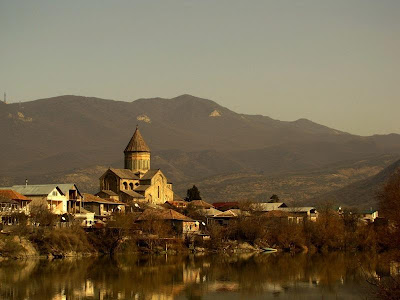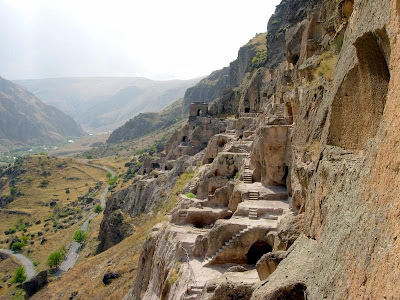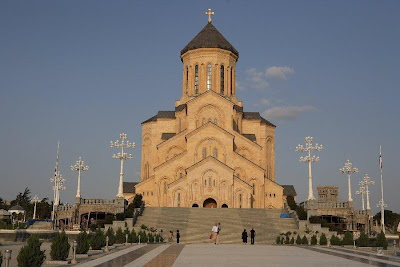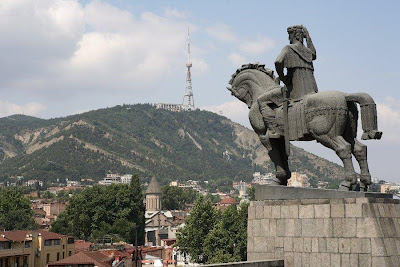 Georgia is in the South Caucasus region of Eurasia, straddling Western Asia and Eastern Europe.[5] Georgia's northern border with Russia roughly runs along the crest of the Greater Caucasus mountain range – a commonly reckoned boundary between Europe and Asia. In Philip Johan von Strahlenberg's 1730 definition of Europe, which was used by the Russian Tsars and which first set the Urals as the eastern border of the continent, the continental border was drawn from the Kuma-Manych Depression to the Caspian Sea, including Georgia (and the whole of the Caucasus) in Asia.
Georgia is in the South Caucasus region of Eurasia, straddling Western Asia and Eastern Europe.[5] Georgia's northern border with Russia roughly runs along the crest of the Greater Caucasus mountain range – a commonly reckoned boundary between Europe and Asia. In Philip Johan von Strahlenberg's 1730 definition of Europe, which was used by the Russian Tsars and which first set the Urals as the eastern border of the continent, the continental border was drawn from the Kuma-Manych Depression to the Caspian Sea, including Georgia (and the whole of the Caucasus) in Asia.Mountains are the dominant geographic feature of Georgia. The Likhi Range divides the country into eastern and western halves. Historically, the western portion of Georgia was known as Colchis while the eastern plateau was called Iberia. Because of a complex geographic setting, mountains also isolate the northern region of Svaneti from the rest of Georgia.
The territory of modern-day Georgia has been continuously inhabited since the early Stone Age. The classic period saw the rise of the early Georgian states of Colchis and Iberia. The proto-Georgian tribes first appear in written history in the 12th century BC. Archaeological finds and references in ancient sources reveal elements of early political and state formations characterized by advanced metallurgy and goldsmith techniques that date back to the 7th century BC and beyond. In the 4th century BC a unified kingdom of Georgia - an early example of advanced state organization under one king and the hierarchy of aristocracy, was established.


Caucaus Folk Dance//Cave New Aphon


Chonguri Panduri//Churchkhela being sold at a roadside Stand


Akaki Khorava state theatre in Senaki//Gudauri
The climate of Georgia is extremely diverse, considering the nation's small size. There are two main climatic zones, roughly separating Eastern and Western parts of the country. The Greater Caucasus Mountain Range plays an important role in moderating Georgia's climate and protects the nation from the penetration of colder air masses from the north. The Lesser Caucasus Mountains partially protect the region from the influence of dry and hot air masses from the south as well.
Georgian culture evolved over thousands of years with its foundations in Iberian and Colchian civilizations, continuing into the rise of the unified Georgian Kingdom under the single monarchy of the Bagrationi. Georgian culture enjoyed a golden age and renaissance of classical literature, arts, philosophy, architecture and science in the 11th century.
The Georgian language, and the Classical Georgian literature of the poet Shota Rustaveli, were revived in the 19th century after a long period of turmoil, laying the foundations of the romantics and novelists of the modern era such as Grigol Orbeliani, Nikoloz Baratashvili, Ilia Chavchavadze, Akaki Tsereteli, Vazha Pshavela, and many others. Georgian culture was influenced by Classical Greece, the Roman Empire and the Byzantine Empire, and later by the Russian Empire which contributed to the European elements of Georgian culture.
Georgian cuisine and wine have evolved through the centuries, adapting traditions in each era. One of the most unusual traditions of dining is Supra, or Georgian table, which is also a way of socialising with friends and family. The head of Supra is known as Tamada. He also conducts the highly philosophical toasts, and makes sure that everyone is enjoying themselves. Various historical regions of Georgia are known for their particular dishes: for example, Khinkali (meat dumplings), from eastern mountainous Georgia, and Khachapuri, mainly from Imereti, Samegrelo and Adjara.


Bedia Cup of King Bagrat III of Georgia//Georgia Tiblis


Eklesia church Batumi//Ottoman mosque in Batumi


Milenium church//Stalin statue in Gori

Area: 69,700 sq km
Population: 4.4 million
Capital City: Tbilisi (population: 1.5 million)
People: 71% Georgian (including subgroups of Svanetians, Mingrelians, Ajars), 7.7% Armenian, 6.5% Russian, 6% Azeri, 3% Ossete, 1.8% Abkhaz
Languages: Georgian 71% (official), Russian 9%, Armenian 7%, Azeri 6%, other 7% note: Abkhaz (official in Abkhazia)
Religion(s): Georgian Orthodox 65%, Muslim 11%, Russian Orthodox 10%, Armenian Apostolic 8%, unknown 6%
Currency: Lari (GEL)


















